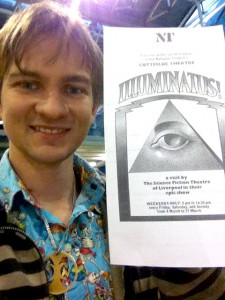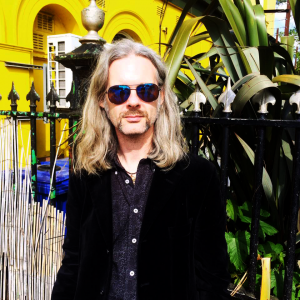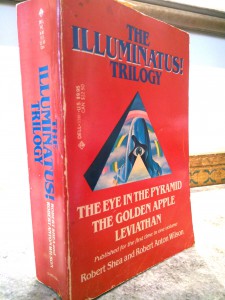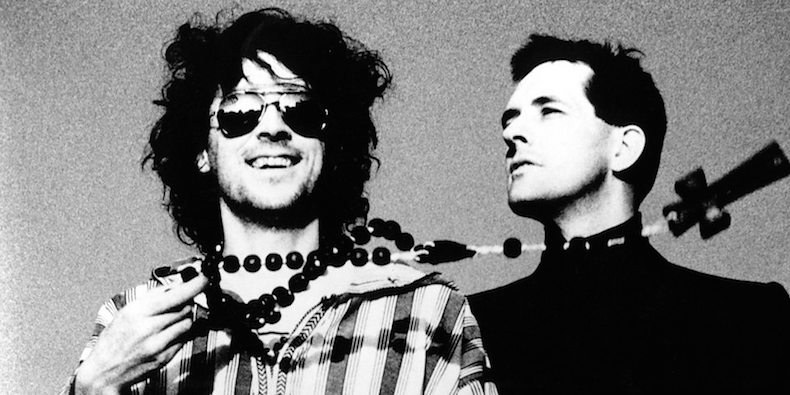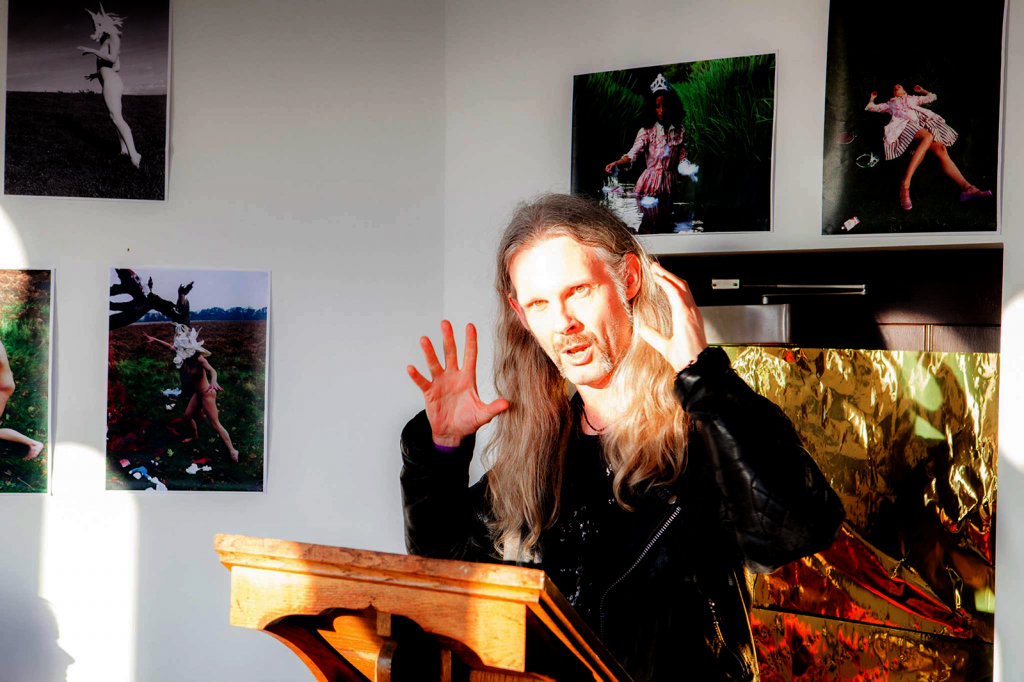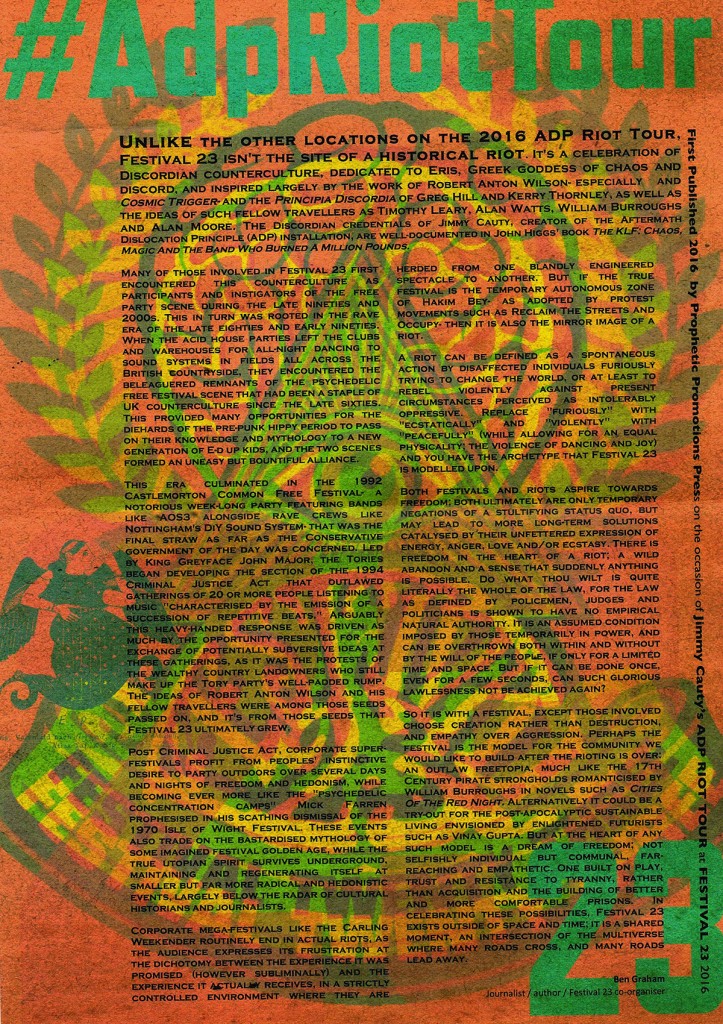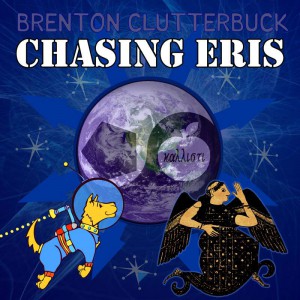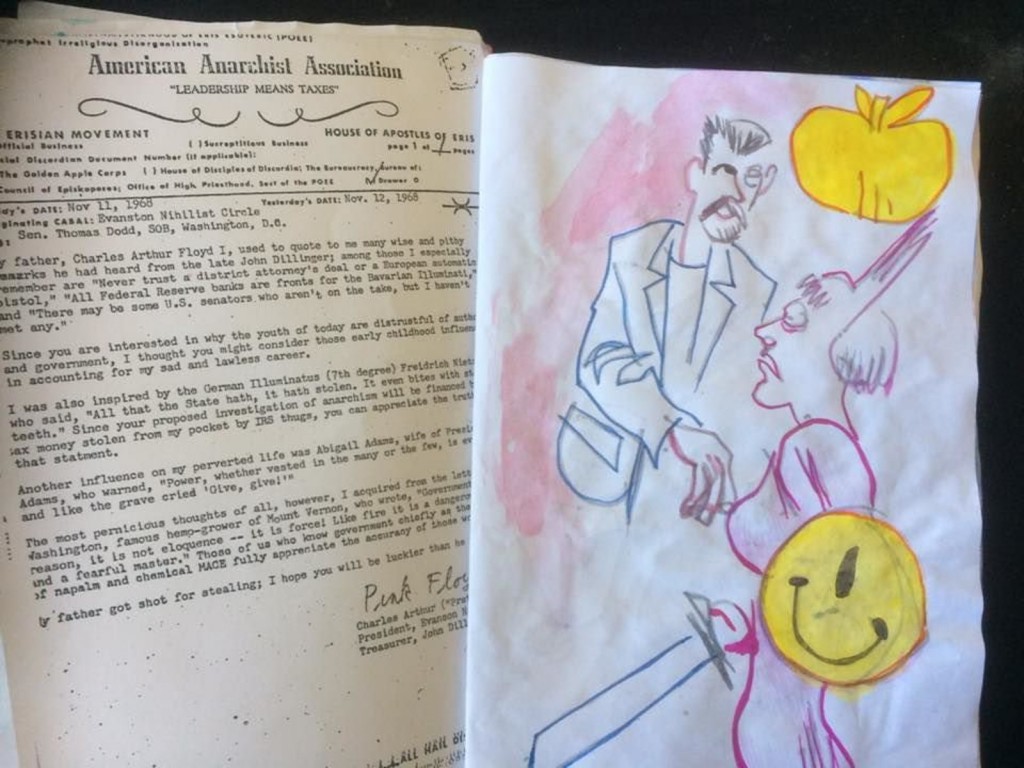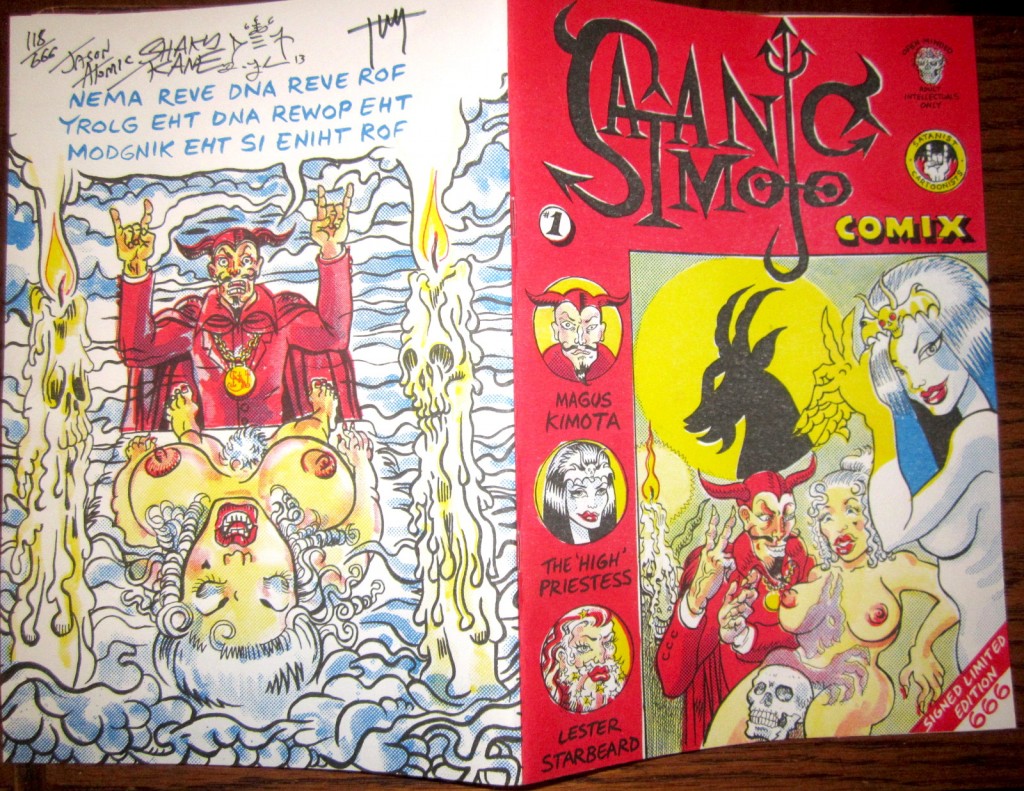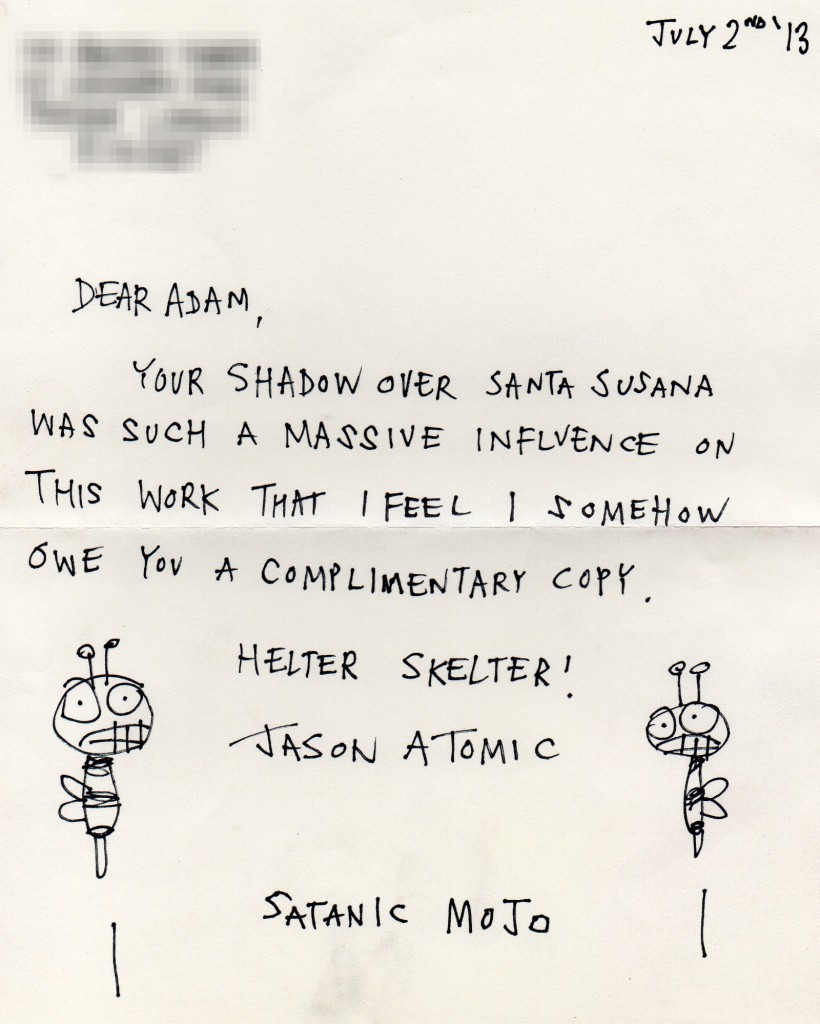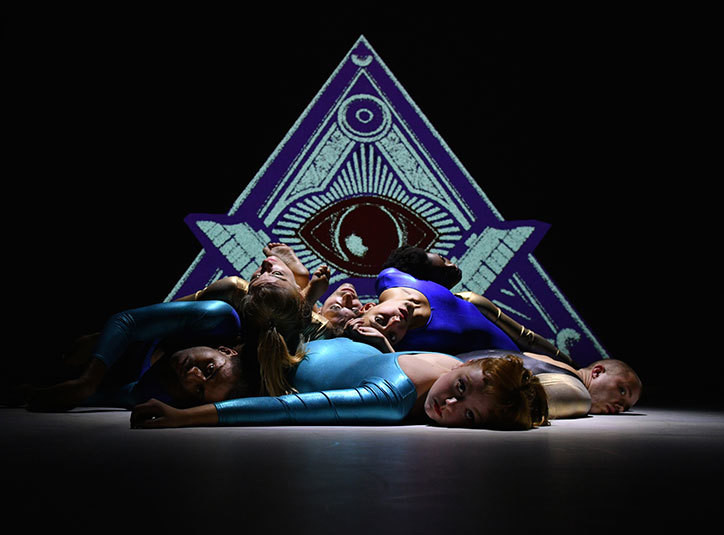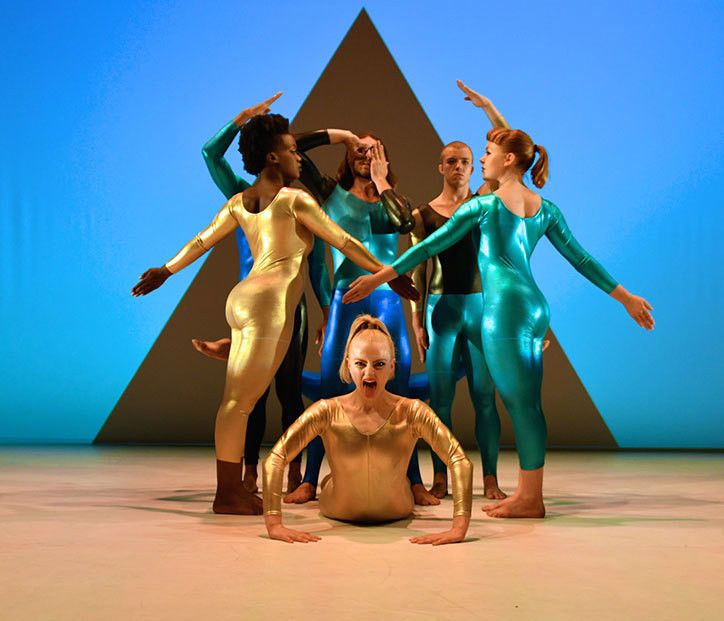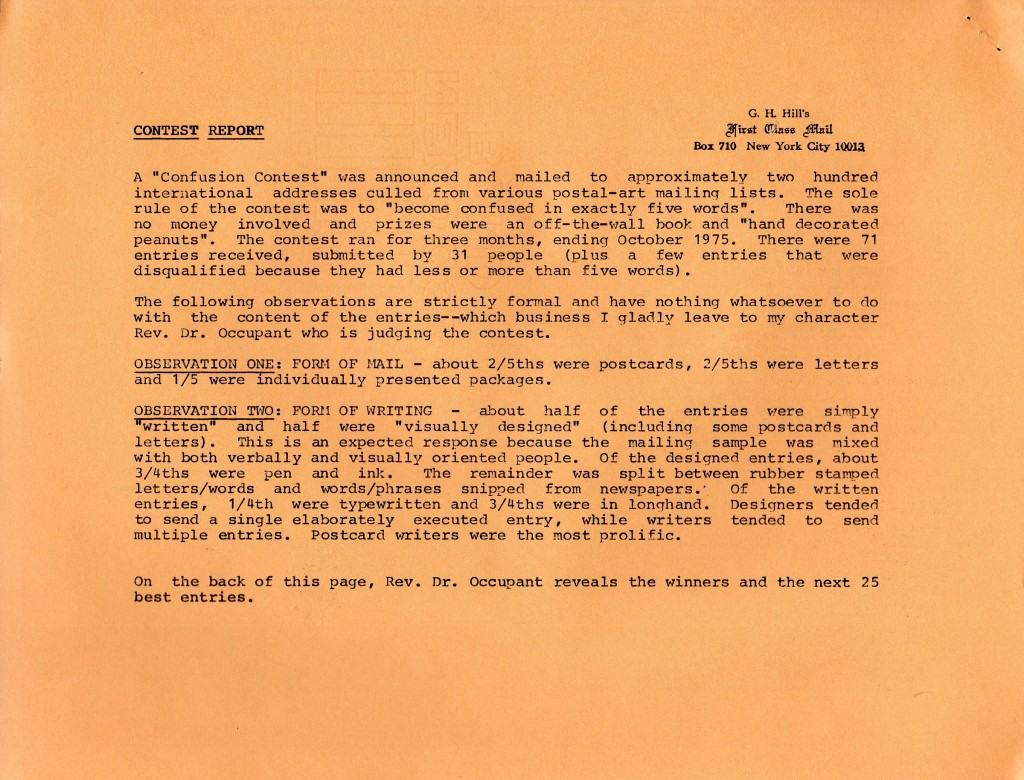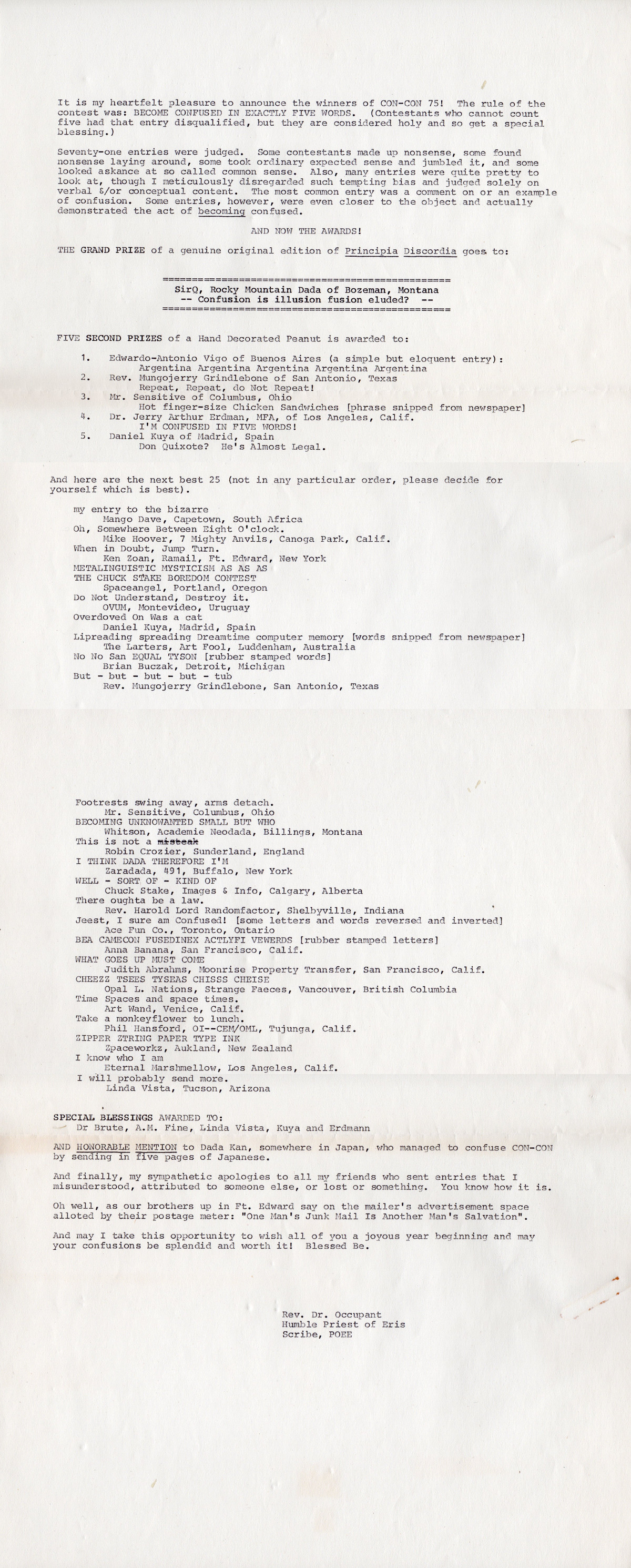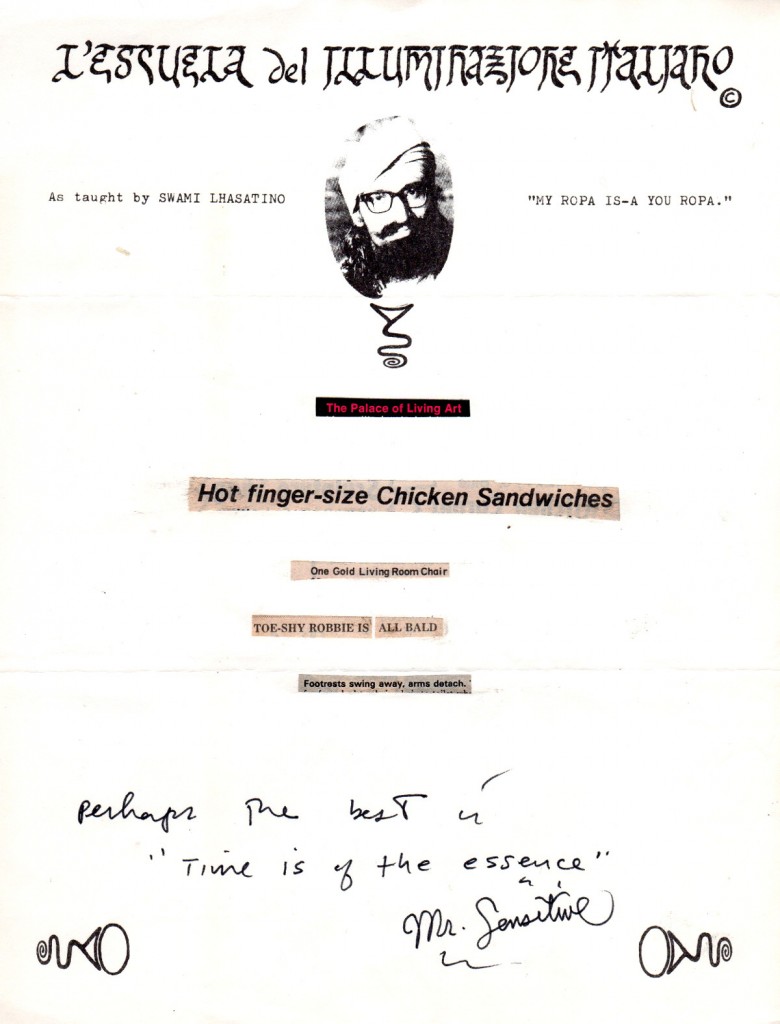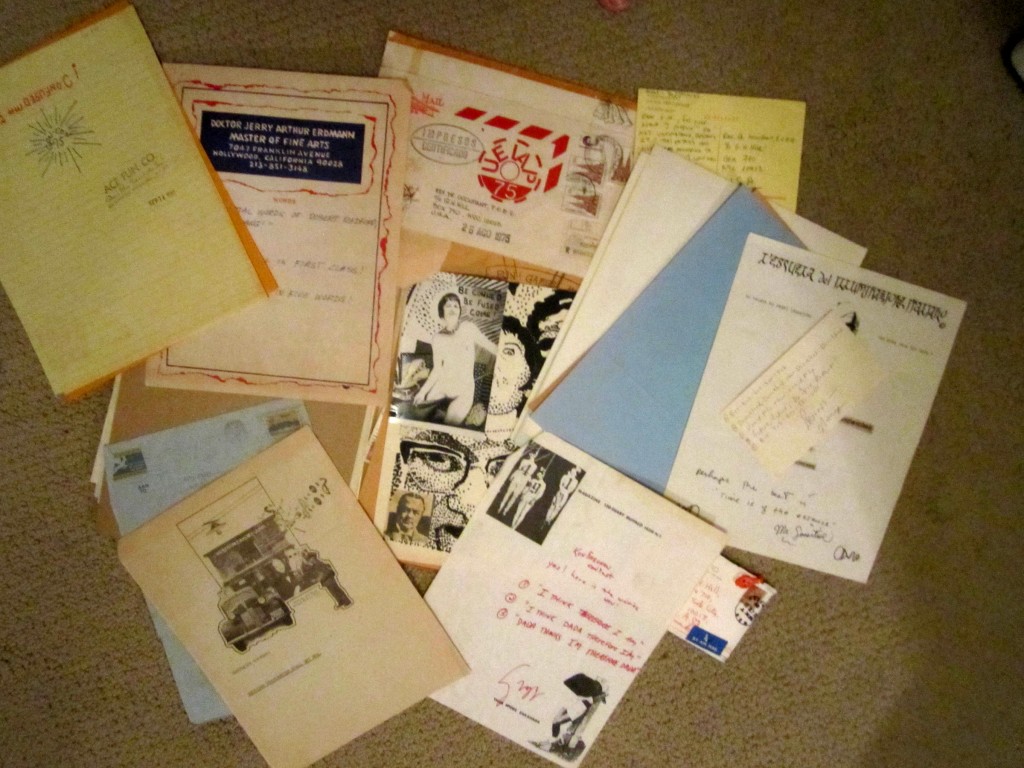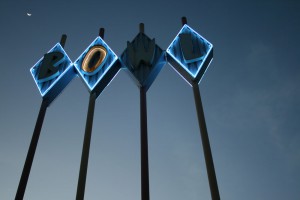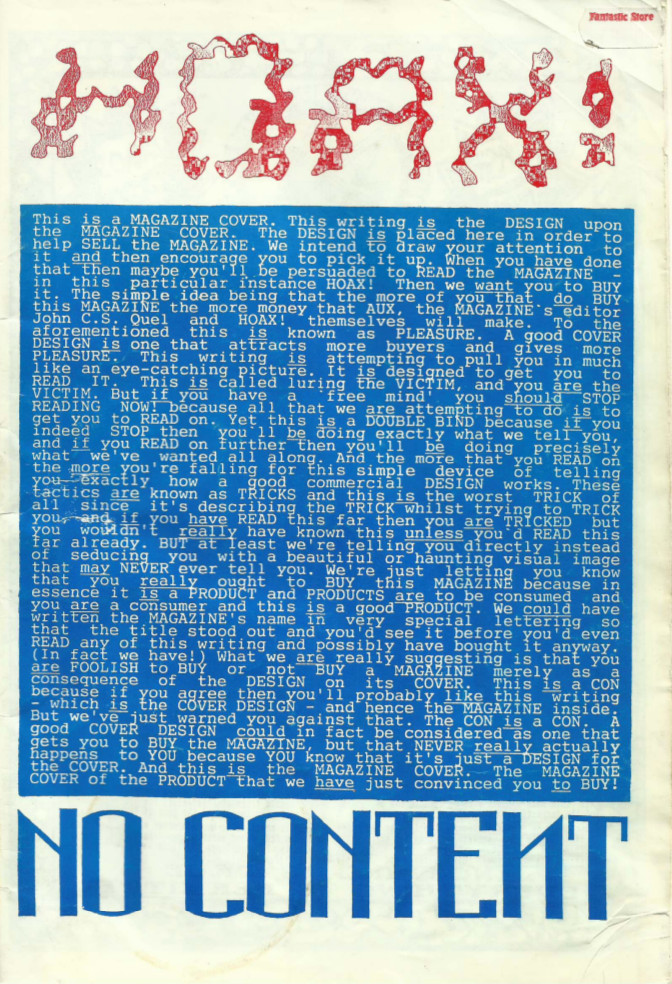The following article previously appeared in a slightly (chemically altered) form in Psychedelic Press Issue 23.

Courtesy of the Discordian Archives.

Courtesy of the Discordian Archives.
The handful of veiled (or perhaps not-so-veiled) drug references in the Principia Discordia include the ritual of Blessed St. Gulik the Stoned (pages 00027 and 00040), an allusion to a Discordian pot smoking ritual. (St. Gulik is a cockroach.)
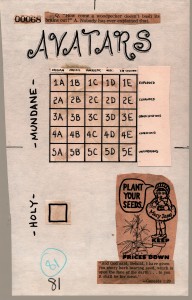
Courtesy of the Discordian Archives.
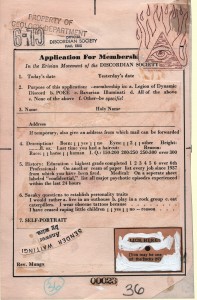
Courtesy of the Discordian Archives
Page 00068 of Principia Discordia featured “Plant Your Seeds,” a covert campaign to plant marijuana seeds throughout the cities of America to turn on the squares. “Lick Here” on page 00023 encourages the reader to stick their tongue on the dot for a special dose of you know what!
Principia Discordia (4th edition) evolved out of what were known as Groovy Kits, manila envelopes packed full of groovy goodies that were circulated by Greg Hill to a snail mail network of popes and momes during the Discordian Society’s halcyon days. Although Discordians have never been big on rules, it was encouraged that—upon receipt of said Groovy Kit—the recipient partook in the Ritual of St. Gulik to suitably prepare their heads before diving into the Groovy Kit goods and creating something likewise groovy to add to the package and then pass it along to the next Discordian on the list. (Rules is rules.) And so, in time, these Groovy Kits grew like some weird fungi, spreading their spores via the U.S. Postal System through the collective brains of those who elected to play the game; an art project made up of a communal Discordian stew of collages, counterculture memes, conspiracy theories, word games, irreverent humor, all of which contributed to the evolution of Principia Discordia which, in turn, provided inspiration for Robert Anton Wilson and Robert Shea’s Illuminatus!
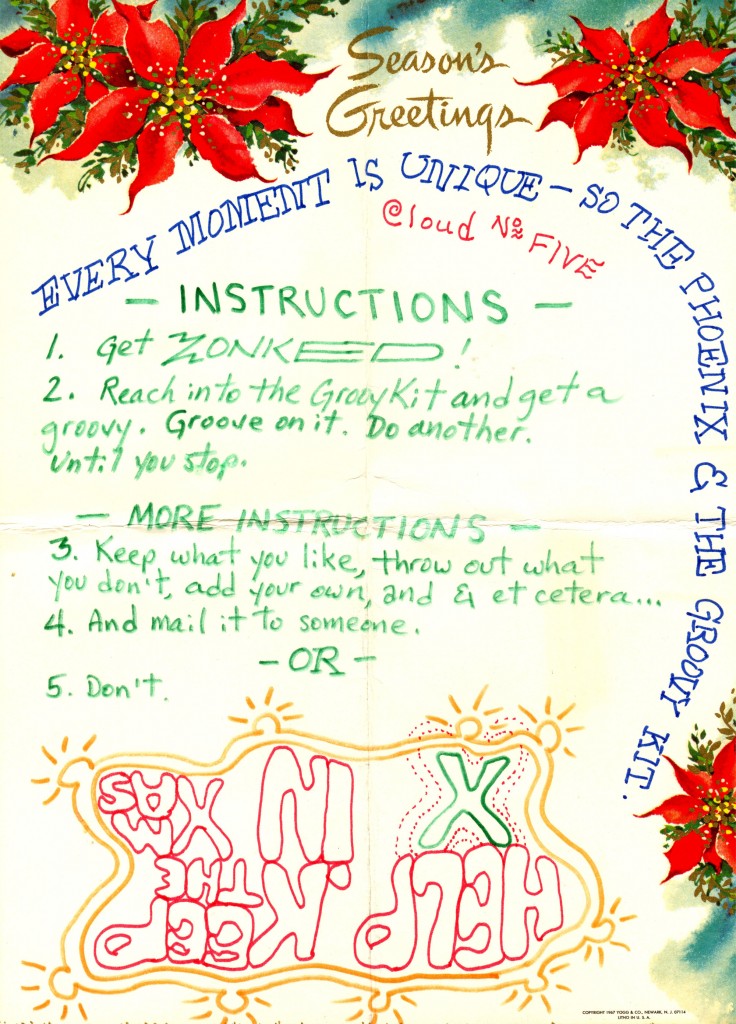
Robert Anton Wilson (RAW) provided some of the earliest reports of Discordian psychedelic experimentation in Cosmic Trigger I: Final Secret of the Illuminati. In 1963, RAW lived in “an old slave-cabin in the woods outside Yellow Springs, Ohio. With my wife, Arlen, and our four small children, I had rented the cabin from Antioch College for $30 per month and had an acre of cleared land to grow food on, 30 acres of woods to seek Mystery in…” It was there, with the aid of peyote, that RAW was able to tap into those ancient nature spirits, this at a time when you could still legally purchase peyote buttons via mail order.
“By mid-1963 [RAW] had logged 40 trips to inner space” and “frequently had the hallucination of telepathic communication with plants, both when flying on the wings of peyote and when [I] was straight… The strangest entity I contacted in those twenty-odd months of psychedelic explorations appeared one day after the end of a peyote trip, when I was weeding in the garden and a movement in the adjoining cornfield caught my eye. I looked over that way and saw a man with warty green skin and pointy ears, dancing.” RAW “watched for nearly a minute, entranced, and then Greenskin faded away ‘just a hallucination…’ But I could not forget him. Unlike the rapid metaprogramming during a peyote trip, in which you are never sure what is real and what is just the metaprogrammer playing games, this experience had all the qualities of waking reality, and differed only in intensity. The entity in the cornfield had been more beautiful, more charismatic, more divine than anything I could consciously imagine when using my literary talents to try to portray a deity. As the mystics of all traditions say so aggravatingly, ‘Those who have seen, know.’ Well, I had seen, but I didn’t know. I was more annoyed than enlightened. But that was not to be my last encounter with that particular critter. Five years later, in 1968, [RAW] read Carlos Castaneda’s The Teachings of Don Juan, dealing with traditional Mexican shamanism and its use of the sacred cactus. Castaneda, an anthropologist, saw the same green man several times, and Don Juan Matus, the shaman, said his name was Mescalito. He was the spirit of the peyote plant…”00001
RAW’s enthusiasm for psychedelics led to his 1964 article for Paul Krassner’s The Realist, “Timothy Leary and his Psychological H-Bomb” the result of an interview he conducted with Timothy Leary in 1964 at the Millbrook Ashram. As RAW noted:
“Later [Leary] asked me if I had majored in psychology, and was surprised to find most of my college years had been in the physical sciences. My knowledge of psychology comes entirely from omnivorous reading and several friendships with people in the field, but it may partially explain why Timothy Leary and I had a different sort of relationship than Tim usually has with writers and journalists.”00002
RAW became an ardent Leary advocate, and in the years to follow the two would forge a close personal and professional bond, co-authoring a number of articles together, as well as developing “The Eight Circuit Model of Consciousness” concept.
RAW continued his psychedelic explorations into the 1970s, incorporating consciousness expansion techniques, wicca, magick, tantra, yoga and in particular a Crowleyean ritual known as the “Conversation with the Holy Guardian Angel.” On July 23rd, 1973—coming down off an acaid trip—RAW was performing this Crowleyean ritual when he came into contact with what he perceived to be entities from the Sirius star system. RAW later discovered that July 23 is the very day when Sirius rises behind the sun, the fabled “Dog Days” as they are called. During this same period, RAW was in correspondence with Leary. As RAW recalled:
“In January 1974, Dr. Leary published Terra II, in which he reported his experiments during July-August 1973, attempting to achieve telepathic communication with higher Intelligences elsewhere in the galaxy. Dr. Leary “received” 19 transmissions—the so-called Starseed Transmissions—which he cheerfully admits may be hallucinations. He presents evidence and arguments that they may also be not-hallucinations.
“As soon as I read Terra II, it was obvious to me that I had somehow, during my yoga [magick] sessions, tuned in on Dr. Leary’s brain-waves. My July 23 communication from Sirius was either part of the Transmissions from the higher minds of the galaxy or was part of Dr. Leary’s hallucination, telepathically shared with me. Dr. Leary, however, did not mention Sirius…”00003
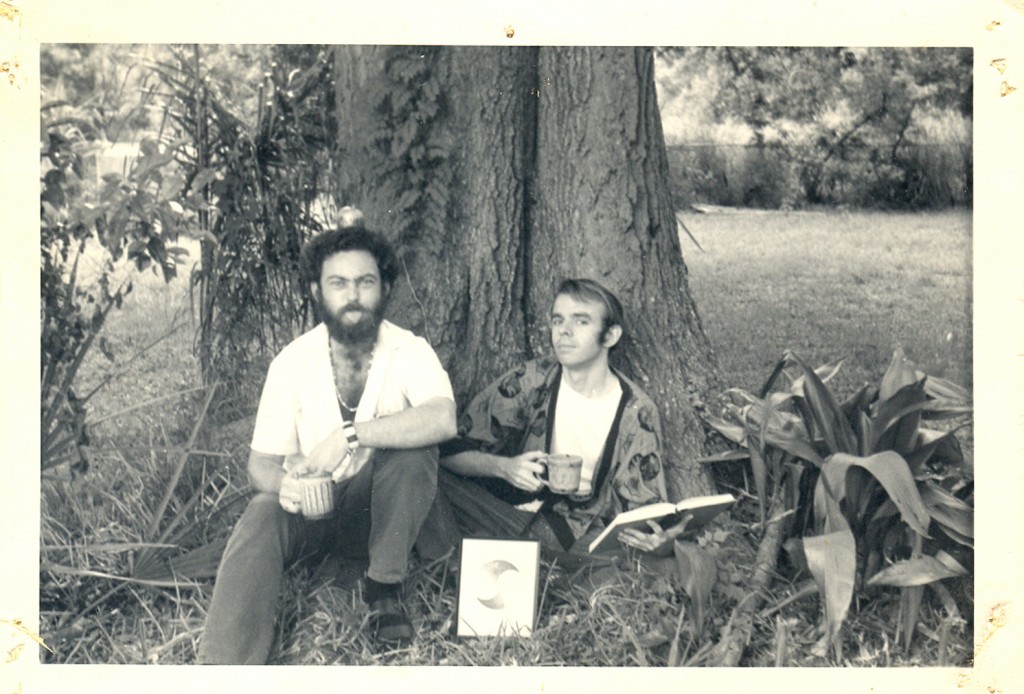
Courtesy of the Discordian Archives.
Greg Hill chronicled his psychedelic experiments in a number of journal entries, including a three page account from April 1965 entitled “An Experience with Mescaline.” (Download here.)
Body becomes helpless with laughter
As whirly-gig bugs return,
But now
Chills are back too
And the room is
Very desolate,
Save one single point
Of life and warmth:
The candle,
Far below on the floor.
As a Holy Guru
The Omniscient flame
Radiates its serenity
To all who
Will accept,
And body is once again granted
Warmth and
Comfort.

Courtesy of John F. Carr.
In the mid 1960s, Kerry Thornley joined Kerista, “a sexually swinging psychedelic tribe” into mate swapping, dope smoking and acid tripping. Renowned for their “beautiful weekend orgies,” Kerista was established in New York the late 1950s by John Presmont (aka Brother Jud). After running afoul of the law in NYC, Brother Jud and his crew moved to Southern California, where they joined forces with Kerry. During this period, Kerry’s income was a total of $50 a week, which he earned from writing “case histories,” most of them factual, for Monogram Publications—a southern California erotica publisher—based on his experiences with the Keristas.00004
In 1966, the group’s newspaper changed its name from Kerista to Kerista Swinger, presumably to generate greater appeal with a new generation of hip sexual experimenters. Kerry—calling himself “Young Omar”—wrote several articles for Kerista Swinger, including the group’s mission statement:
Kerista is a religion and the mood of Kerista is one of holiness. Do not, however, look for a profusion of rituals, dogmas, doctrines, and scriptures. Kerista is too sacred for that. It is more akin to the religions of the East and, also, the so-called pagan religions of the pre-Christian West. Its fount of being is the religious experience and that action or word or thought which is not infused with ecstasy is not Kerista. And Kerista, like those religions of olden times, is life-affirming.
By 1967—the so-called “Summer of Love”—Kerry’s politics had gone through a radical shift. His rallying cry was now “sex, drugs, and treason”—everything that flew in the face of a conservative agenda he’d previously embraced with his enthusiasm for Ayn Rand styled Libertarianism. As Kerry later wrote:
When the conservatives began complaining that radical students were interested in nothing but “sex, drugs, and treason” I realized that, instinctually, they had hit the nail on the head. Sex, drugs, and treason were the three things I stood for…. Regarding sex, I became firmly convinced that unless there were trends established in our culture in the direction of uncompromising sexual honesty, tolerance for minority sexual preferences, equal treatment of the sexes, rational openness concerning VD and birth control, and saner attitudes regarding sex and child-rearing, particularly with reference to masturbation—further meaningful social change would not be possible…
Regarding drugs, I gained a great deal of respect for psychedelic substances as powerful tools for restructuring portions of one’s personality which could not be reached by intellectual effort alone, for expanding one’s sense of identification and compassion, and for opening the narrow and dry Western ego to mystical possibilities. Zen and similar styles of meditation, along with the yoga disciplines, I came to see as methods for maintaining psychedelic levels of awareness, once the chemicals had demonstrated the nature of such modes of consciousness…
Regarding treason, I came gradually to a position of supporting nearly all factions on the radical left, except in their quarreling with each other and the dogmatic insistence of some of these groups on the insistence of political violence (or, in other cases, the immorality of violence under all circumstances). I came to this position without ever abandoning some of the more libertarian elements on the extreme right. Meanwhile, I continued to refine my own political philosophy of anarchism—not because I favored “violence and chaos” with which anarchism is nearly always falsely equated, but because of my opposition to violence and chaos, for which government military machines and bureaucratic structures are largely responsible in today’s world…00005

Courtesy of Louise Lacey.
Kerry Thornley helped organize the Griffith Park Human Be-Ins, which were the perfect set and setting to display his irreverent brand of humor. At the first Be-In, Kerry cut a singular swath, equipped with a sign that read: “Stamp out quicksand. Ban LSD.” Fellow Discordian Louise Lacey (Lady L., F.A.B.) recalled the first Griffith Park Be-In thusly:
The weather was perfect. We were all stoned. A single engine plane came and circled, and I thought it was the media, keeping track of us, but then a man all in white dropped down with a parachute and the crowd roared with approval. Later I learned that an old friend of mine from Marin County was the pilot. He got that plane out fast, because it was illegal to parachute within the city limits.
The Be-In was fascinating because I had never seen such a large collection of freaks. I couldn’t keep from grinning. I was particularly interested because some hard assed sociologist had said that when you were on LSD you were extremely susceptible to being led. I was watching for people being led.
I saw a group of people organized into a crack-the-whip game. Twenty or twenty-five people formed and a man with a megaphone was giving them instructions. (Definitely planned.)
“Move up the hill, move down. Hang on tight. Join with more people.” I couldn’t tell if anyone was listening or just all having fun. The people at the end of the line were moving so fast they kept being thrown off, tumbling down the hill in the grass, laughing hysterically. Then some of the crack-the-whip people let go of the hands of the people around them and drifted off. The megaphone man yelled more loudly. “Hang on, don’t let go.” More people drifted away. He was screaming now. The group all dropped hands and disappeared in the crowds and the megaphone man was screaming at the top of his amplified voice, “Come back! We are playing a game here!” But the people were gone.
I didn’t worry any more about what that sociologist had said.
Many groups of people were gathered as “families of friends.” It was the first time I had seen this form of organization. So there were tents, and lean-to’s and lots of signs pounded into the dirt, describing one thing or another to identify who the friends were. (This is where Kerry’s sign fit in.) As I didn’t live in L.A., I didn’t recognize anyone other than Kerry’s friends, who didn’t stay around his sign, but it didn’t matter. I “knew” the strangers as friends, and we laughed and hugged and shared doobies, and listened to music and I moved on. Nobody got hurt, everyone had a good time (except, I imagine, the man with the megaphone). As the day progressed, I gravitated back to Kerry’s sign and others did, too, and we shared what we had experienced, eventually gathered our stuff and drove home to Kerry’s. A most successful day.00006
At the time, Kerry had moved into a house in the Watts section of Los Angeles that became a sort of psychedelic social center. One frequent visitor to this scene was Kerry’s friend, Bud Simco, who recalled:
“Kerry was charismatic and had the ability to attract diverse personalities, people who would normally not be associated with each other, except by the force of Kerry’s personality. For example, there were so-called hippie types tripping under the dining room table, holding burning candles in their hands, while right-wing types were holding forth in the kitchen. One such character I recall had never been to Watts before, and showed up wearing a bullet-proof vest and armed with a .45. He seemed reasonable enough, in conversation, but he was taking no chances [having never been around hippies before]. There were people from all walks of life… including a pilot for the Flying Tiger Airlines, a student from MIT, some swingers, a fashion model, some writers, some SDS student types, and various and sundry others whom I did not know. One of my guests at one particular gathering was a former motorcycle gang member who lost his foot in a motorcycle accident, and his beautiful American Indian wife, who was at the time a co-worker of mine. He had never seen such an assorted group of people in his life, for example, but with his tambourine, magic mushrooms and a Donovan LP loudly playing, asserted his presence along with all the diverse others in one righteous happening. The thing is, everyone was tolerant of the other, regardless of individual inclinations and/or politics. At such an event, many people would never even interact with other groups, in other rooms, although many did. That was the one universal factor re: being present at one of Kerry’s gatherings, either at his home in Watts, or perhaps at one of the original “Be-Ins” at Griffith Park…”00007
A frequent visitor to Kerry’s house in Watts was John Overton who after his first acid trip changed his name to Camden Benares, the idea of which was to bring the teachings of the East into the West: “Camden” for Camden, New Jersey, and “Benares” after Benares, India, the city where the Buddha delivered his first sermon. Benares went on to write the classic Zen Without Zen Masters and was a contributor to the Principia Discordia with “A Zen Story” on page 00005. Camden’s Discordian name was Felix Pendragon. Felix—according to Discordian legend—always carried a pen, and in said pen was a joint. So, when somebody asked Camden who Felix Pendragon was, he’d take out the pen, remove the joint, and “drag on” it.
While this scene was happening at Kerry’s Watts house, Greg Hill was finishing up his military service. After his discharge in early ‘68, he relocated to San Francisco, and ramped up his Discordian activities while immersing himself in the burgeoning counterculture. Among these endeavors included the “Plant Seeds” chain letter he anonymously forwarded to underground papers and news outlets courtesy of “The Discordian Society.”
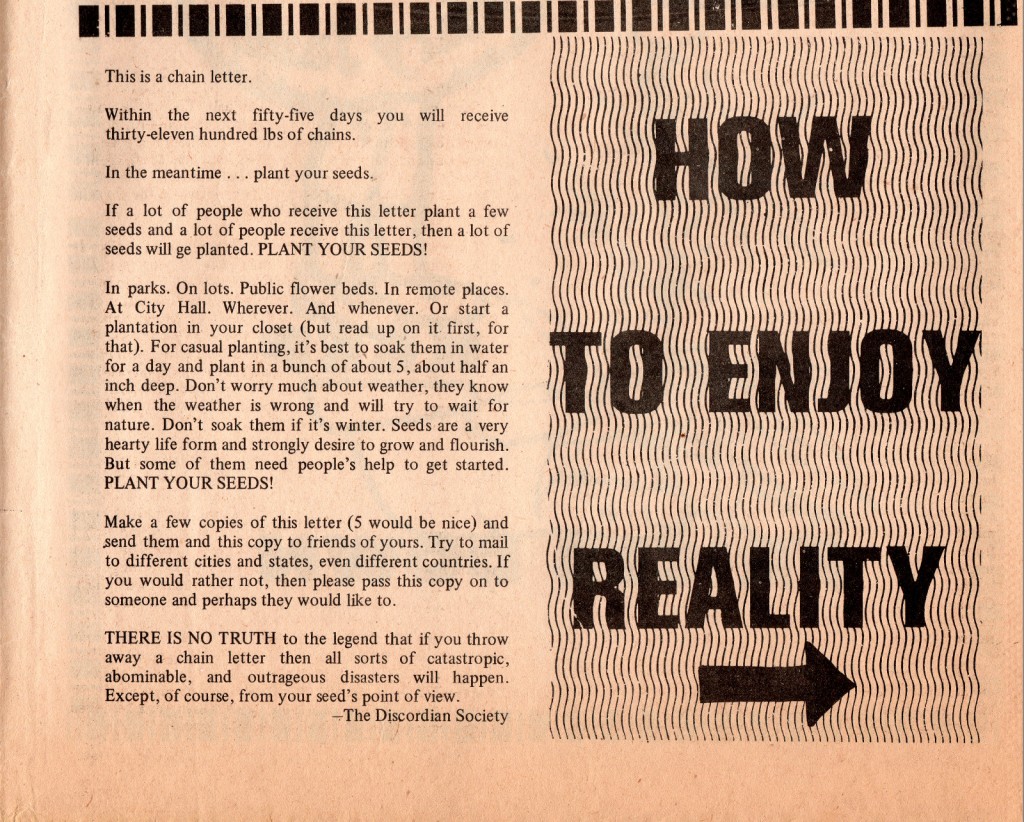
Courtesy of the Discordian Archives.
In addition to disseminating Groovy Kits to his circle of Discordian co-conspirators, Hill interacted with many of the psychedelic luminaries (and trouble makers) of the era, including Tim Leary, Art Kleps of the Neo American Church (author of the Boo Hoo Bible) and Jefferson Poland (aka ‘Jefferson Fuck Poland’) of the Psychedelic Venus Church, among others, often joining their respective psychedelic churches and receiving certain sacraments through the mail. One batch of illuminating correspondence that Hill received from Kleps included a curious index card:

Dr. Robert Newport was another long time friend of both Hill and Thornley as well as contributor to the Principia Discordia with “The Parable of the Bitter Tea” (page 00037) In Brenton Clutterbuck’s book Chasing Eris, Newport recalled his introduction to LSD:
“I was in this psychiatric residency in California in the late 1960s, and the world was in turmoil…. I had been struggling to keep up with all of it, then Greg [Hill] showed up with LSD, and that was goodnight… I had taken LSD months before I left for Okinawa [drafted into the military]… my head was just completely blown apart. And the hostility and violence of the military—I was not obeying too much. I became a revolutionary; I was doing all kinds of things that could have gotten me court-martialed. I didn’t because I tended to be smart enough to stay ahead of whomever… But eventually I was totally stupid and got myself kicked out, which was OK. I didn’t belong there anyway.” 00008
Greg Hill addressed Newport’s troubled military service in his Discordian newsletter The Greater Poop:
The Rev. Dr. Hypocrates, [Newport], has returned from his Okinawa Mission and is presently at Norton Cabal awaiting developments. Brother Hypoc, as you may or may not know, is a POEE psychiatrist who completed his residency in Berkeley a year ago and then promptly got his ass drafted into the United States Air Farce. Poop readers may recall a Xerox of Hypoc’s dog tag which started “Erisian” for religion (issue #6)…
Brother Hypoc [Newport], narrowly escaping legal prosecution, for some LSD antics, because of his professional status as an MD and his privileged status as an Officer, is presently trying to discharge the Pentagon from his life. Human beings in comparable situations but without Privilege Status, of course, are routinely crucified, caged, or psychosmashed by the pig machine, but they couldn’t send Hypoc to the Base Psychiatrist because Hypoc was the Base Psychiatrist, and he advocates that military psychology be in the service of mental health. Due to the awkwardness of the Military’s position, a discharge seems realistic—as soon as Big Uncle finally understands that Rev. Dr. Magoun has sworn the Hippocratic oath as a healer and finds it his moral obligation to RELEASE every person he can from the destructive and corruptive state of being in which the government confines US Citizens for the purpose of turning human beings into soldiers…
This loose-knit Discordian network in which Greg Hill found himself front-and-center was similar to the scene that revolved around Kerry Thornley’s pad in Watts; a colorful coterie of personalities moving from one end of the political spectrum to the other; a melting pot of freaks interested in alternative religions, sexual experimentation, psychedelics, political activism, the civil rights and the back-to-nature movements—with a dash of whimsy and irreverence added in—all of these cultural currents were part of this Discordian letter writing circle that Hill orchestrated.
While some of the Early Discordians have been associated with Libertarianism, it should be noted that their brand of Libertarianism had more to do with hippies and Yippies and freaks of all stripes than it did with current Libertarian strains. The Discordian Society’s involvement in these earlier Libertarian strains concerned their opposition to government overreach into our bedrooms and brains; whereas, nowadays, those who identify themselves as Libertarianism are, in many instances, focused on gutting environmental regulations, which runs counter to where many of the Early Discordians heads were at, such as Louise Lacey, who was more of the Anarcho-Libertarian persuasion: pro-environment and at the same time anti-privatization of land. Louise was one of the founders of the Earth People’s Park.
How can one man own another man?
How can one man own another’s time?
How can he own another’s energy?
How can he OWN a piece of the sky, or the sea, or the earth?
“And who shall command the skylark not to sing?”—Earth People’s Park brochure (2/70)

Photo Courtesy of Mary Wheeler.
A couple other Early Discordians, Tim Wheeler (Harold Randomfactor) and his wife Mary Wheeler (Hope Springs) were about as conservative (politically) as you could get, although with an abiding enthusiasm for the Ritual of St. Gulik. To this end, Wheeler cultivated a marijuana crop on his farm in Indiana to help supplement his income as a humor writer for the National Review. As Mary Wheeler reminisced:
“When we moved to Indiana, we had 25 acres of land, and three acres surrounding the house; that is, not under cultivation. Yes, we grew a lot of pot—it kept us afloat through those years. It was an income for us, though it simply horrifies me now to think how reckless we were. I don’t know about the others [Discordians], but we smoked just for the feel good. No thoughtful insights, no magical apparitions. We smoked with a couple of our conservative friends, but I don’t know about the others. My guess is that everybody smoked, but most people didn’t gab about it…”00009

In the early-70s, Bob Newport relocated to the Russian River area, north of San Francisco. At the time, land was dirt cheap there and he was able to acquire a couple of properties, one of which was a five-hundred seat movie theatre—located in a converted military Quonset hut—named The Rio Theatre.
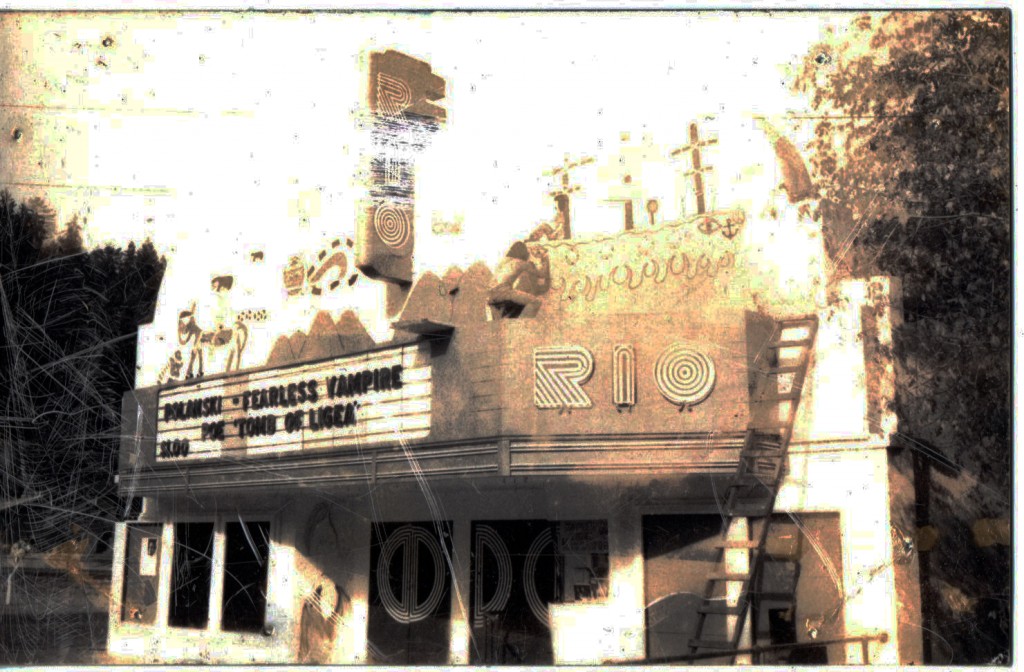
Courtesy of the Discordian Archives.
Newport enlisted Greg Hill and his wife Jeanetta to co-manage the theatre, and over time Cinema Rio became a community effort, a theatre by and for the local freaks, who had fled city life to live among the redwoods along the river in a back-to-nature setting. Cinema Rio was unique in the sense that it was a community effort, a theater by and for the local freaks. In this spirit, artists helped decorate the building, which included a marquee with a free-flowing Mayan theme painted by Wilfred dePaola. Once a month, all the locals who worked at the theatre would gather for a party/meeting and select the films for the following month, usually titles that reflected the counterculture, like Easy Rider or Woodstock.

Courtesy of the Discordian Archives.
During this period, Newport operated a psychiatry practice at a property he acquired in nearby Guerneville with a sign at the entrance that read: “Trespassers Welcome.” The property consisted of an acre and a half, with several cabins scattered throughout the redwoods. Newport was also heavily involved with the psych department at nearby Sonoma State; his “office” was located in a tree house on the property, in the center of a circle of redwoods, in addition to a fifteen-foot hot tub where Newport conducted group therapy sessions.
Newport became dissatisfied with the local public school system and decided to home school his children:
“I put together a small school on my property,” Newport recalled, “because I didn’t want to send my kids to the public school, which was horrendous; it was a redneck school and the teachers hated hippies and tortured kids—I mean they were just terrible to the kids who were going there—so I started a school for my kids and hired a governess out of San Francisco… a licensed, credentialed teacher who was also dropping out, and she came up, and that lasted about three days before word got out, and suddenly I had 20 kids in school, and that then started a home schooling movement and we had eight different schools. In all the satellite communities we had close to 300 kids from K to 12, all with teachers who were dropping out, but credentialed… we started a school board and my wife and I administered all of the schools on a budget of 50,000 bucks, which was like charging parents who could afford it 20 bucks a month to put their kids in school, and parents who couldn’t afford it put their kids in school for nothing because we were not in anything to make money…”00010
RAW—who had relocated just north of Guerneville, in Rio Nido—was a frequent visitor to the Russian River scene, and his son, Graham received psychological counseling from Newport, which in turn led to interactions with Tim Leary. As Newport recalled:
“[Leary] and I had an interchange one day. He wanted to talk to me about Bob [Wilson’s] son, shortly when he was breaking and coming apart. So I talked to him about it, and [Leary] had, as far as I could see as a psychologist, as little empathy, real empathy, and as little understanding of schizophrenia as anybody I’d ever met. And it just pissed me off. I was really hoping I was going to get something… So he and I never interfaced really well after that. And Bob sort of rescued Leary, over the objections of a lot of the hip community who felt that Leary had really sold out a lot of people to enumerate his own problems with the law. And there were a lot of people who were pissed off at Bob, too, for doing that. I would do anything to get anybody out of prison, but I don’t think I’d sell out my friends to get myself out of prison and he basically did that. So I basically didn’t have much regard for him after that. I like the stuff he wrote but I didn’t think much of him as a human being.”00011
Not long after opening The Rio Theatre, an old redwood dance hall across the street from the theatre came up for sale, which Newport and Hill purchased and started a community center there that included a restaurant called Stone Soup, in addition to a food co-op, a health clinic (ran by a doctor who had dropped out), as well as an office for the community newspaper.
“A few rock musicians would come through… and all summer long we had these concerts which we organized, and as part of the concert we fed people. A lot of kids would drop through with nothing and were on the road and hungry and on weekends they could sleep on the beach and count on getting fed…”00012
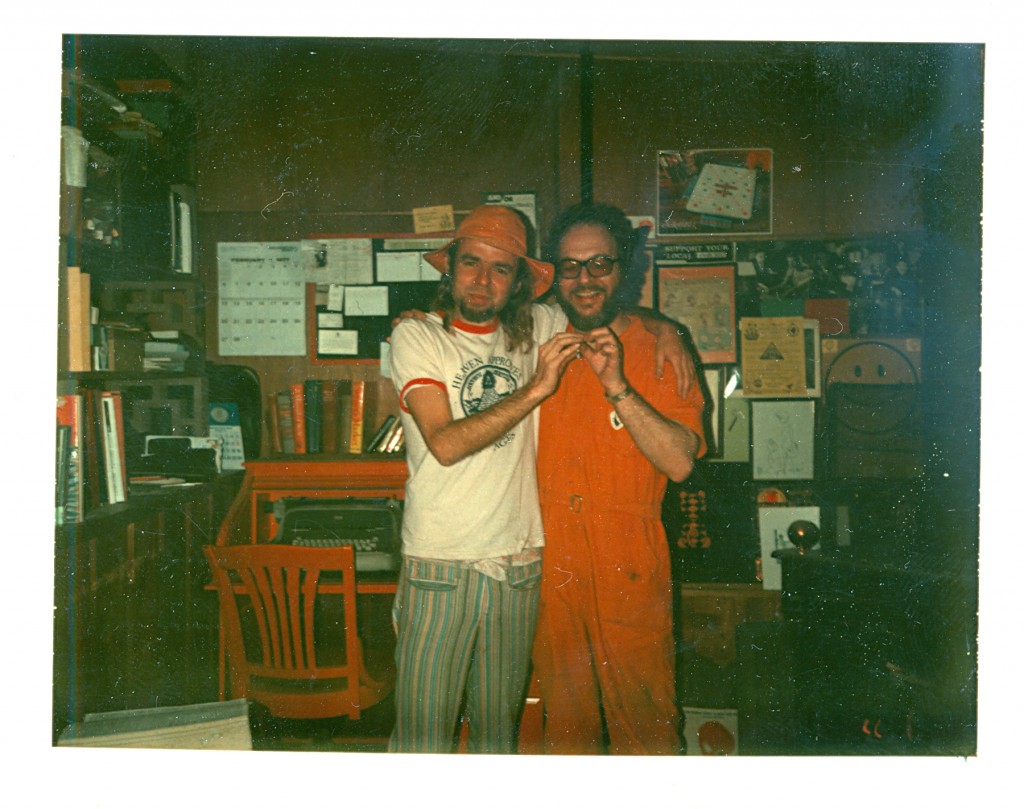
Photo courtesy of John F. Carr.
Meanwhile, Camden Benares had his own scene going on a few miles south of Monte Rio at Camp Meeker, which consisted of a cluster of summer cabins that had been overrun by hippies. Kerry Thornley joined Camden there in a lifestyle dedicated to hedonism and assorted forms of Discordian debauchery. At the time, Camden was married to his second wife, Melissa, and mate swapping was a common theme at Camp Meeker, as both Camden and Kerry had been into swinging going back to his days with Kerista in the mid-60s. Kerry and Melissa were an item for awhile; Kerry referred to her as “his ambassador to the world.” Another member of the party was a six-foot-two tall lady named Jerry.
During this period, Benares was writing erotica for The San Francisco Ball. Kerry was also a frequent contributor to The Ball, chronicling his opinions in a column called “Erotic Minority Liberation,” a 13-part series where he defended nearly every taboo under the sun, including exhibitionists, voyeurs, fetishists, transvestites, nymphomaniacs, obscene phone callers, animal lovers, and sadomasochists.
For shits and giggles, Camden sent out sporadic dispatches to his Discordian friends under the title of The Camp Meeker Truth and Foma Forum.
Benares was also working on a book project, Zen Without Zen Masters, which was subsequently published in 1977 and, like Illuminatus!, dedicated to the dynamic duo of Thornley and Hill.
Cinema Rio and the Monte Rio Community Center eventually folded in the spring of 1973, largely because Newport and Hill were over-extended financially. But there were other factors, as well, which caused the scene to run its course, namely the dissolution of Greg’s marriage to his wife, Jeanetta. As Newport recalled:
“It would have been a miracle if the marriage had survived. Life at the River was incredibly difficult. I mean it was wild, it was high and it was fun, it was creative… and there was no money, which meant that just trying to scrimp by with a living was hard to do… It was hard for me, too. I mean I had a little income because I had a practice going. But the theatre made no money—that cost us money. All these other activities we had going—none of them made money… So things were incredibly stressful. And when the marriage broke up, Greg became very depressed. And basically about that time, my mentor who lived next door to me, who had been a very interesting old man, who had dropped out as a President of Union Bank, and had come to the River, and had a very interesting Libertarian philosophy… ah, anyhow, he died, Jeanetta left, and pretty much everything collapsed…”00013
Psychedelic experimentation continued coursing through the Discordian bloodstream well into the 1970s. In a December 1974 letter, Newport reported to Greg Hill that “There’s a new psychedelic out – Legal, too, still – Ketamine HCL. Dosage 100mg. By I.M. injection – Cosmic consciousness in 4 min. Lasts 1 hour – 2 additional hours to come back down – Brand names Ketaject & Ketalar – Ask a long-haired doctor for a prescription.”

on an Altair Design coloring book page.
Courtesy of the Discordian Archives.
On November 23, 1976—which just so happens to be a holy Discordian Holiday, both due to the mystical manifestation of the number 23 and because it’s Harpo Marx’s birthday—an Englishman named Kenneth Campbell premiered a ten-hour stage production of Wilson and Shea’s Illuminatus! novel at the Science-Fiction Theatre in Liverpool. In true Discordian fashion, the production consisted of five plays of five acts (according with the Discordian Law of Fives) with each act 23 minutes in duration. As RAW wrote in Cosmic Trigger:
Campbell’s adaptation was totally faithful to this nihilistic spirit and contained long unexpurgated speeches from the novel explaining at sometimes tedious length just why everything the government does is always done wrong. The audiences didn’t mind this pedantic lecturing because it was well integrated into a kaleidoscope of humor, suspense, and plenty of sex (more simulated blow jobs than any drama in history, I believe.)00014
RAW and his co-author Robert Shea traveled to London to attend the production of Illuminatus! According to some accounts, RAW came bearing LSD tabs which he passed out to the cast members before the play commenced. As he recalled:
“The cast dared me to do a walk-on role during the National Theatre run. I agreed and became an extra in the Black Mass, where I was upstaged by the goat, who kept sneezing. Nonetheless, there I was, bare-ass naked, chanting ‘Do what thou wilt shall be the whole of the law’… and I will never stop wondering how much of that was programmed by [Aleister] Crowley before I was even born.”00015
The following year, a Discordian reunion took place that included RAW and his wife Arlen, Bob Newport and his wife Rita, Louise Lacey and Greg Hill who traveled to Seattle to attend the U.S. performance of the Illuminatus! stage play.
‘Twas a chilly night in Seattle, so someone (who shall remain nameless) produced enough MDMA for one and all (ingested between the second and third acts) which in due time took the chill from the bones of the assembled Discordians—and cranked up the glow surrounding their collective auras—as they sat enraptured, entranced by the spectacle. Louise Lacey recalls the Illuminatus! stage production as a “sublime experience.” As usual, laughter was a common theme. On the plane to Seattle, the group laughed all the way there, and in Seattle they laughed all through the stage play, laughed the rest of the night, and laughed all the way back home….00016
Notes
00001 Wilson, Robert Anton. 2016. Cosmic Trigger I: Final Secret of the Illuminati. Hilaritas Press. (Pages 22-23)
00002 Wilson, Robert Anton. Starseed Signals: Link Between Worlds. Unpublished manuscript. (Page 19).
00003 ibid. (Page 18)
00004 Gorightly, Adam. The Prankster and the Conspiracy: The Story of Kerry Thornley and How He Met Oswald and Inspired the Counterculture. Paraview Press. (Page 49)
00005 Thornley, Kerry. 1975. Untitled paper. Courtesy of the Discordian Archives.
00006 Gorightly, Adam. The Prankster and the Conspiracy: The Story of Kerry Thornley and How He Met Oswald and Inspired the Counterculture. Paraview Press. (Page 60)
00007 ibid. (Page 50)
00008 Clutterbuck, Brenton. Chasing Eris. (Page 51)
00009 “The Secret History of Immanentizing the Eschaton: The Mary Wheeler Interview”, historiadiscordia.com. November 2, 2014.
00010 Clutterbuck, Brenton. Chasing Eris. (Page 53)
00011 Excerpt from Brenton Clutterbuck’s interview with Robert Newport, 2012 .
00012 Clutterbuck, Brenton. Chasing Eris. (Page 53)
00013 Gorightly, Adam. The Prankster and the Conspiracy (p. 140). Cosimo, Inc. Kindle Edition.
00014 Wilson, Robert Anton. 2016. Cosmic Trigger I: Final Secret of the Illuminati. Hilaritas Press. (Page 224)
00015 ibid.
00016 Gorightly, Adam. The Prankster and the Conspiracy: The Story of Kerry Thornley and How He Met Oswald and Inspired the Counterculture. Paraview Press. (Page 210)
